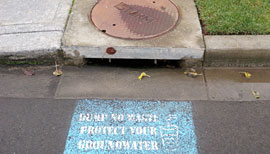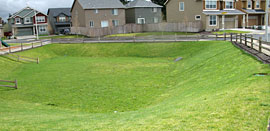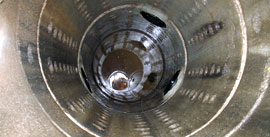How facilities work
Some facilities are simple and small, such as a biofiltration swale with mowed grass. Others are complex, such as a system of ponds and underground structures (multile facility systems). All are designed to capture stormwater and treat it – usually by collecting it and filtering contaminants.
Collect and transport stormwater
Stormwater systems typically consist of catch basins and pipes and/or open channels (ditches). They are large enough to handle runoff from infrequent, large storms. Typical system failures include reduced capacity because of clogged grates or pipes and or ditches blocked with weeds or debris. If the capacity of the conveyance system is reduced, isolated flooding and property damage can occur.
Hold and reduce water flow
Some facilities detain and slow the flow of stormwater to surface waters. Roads, roofs and other hard surfaces increase the rate of stormwater runoff into natural streams, potentially causing stream or channel erosion and flooding. Detention facilities, such as ponds and underground vaults, store stormwater for controlled release and help prevent downstream flooding and erosion.
Store and treat runoff
Retention facilities, such as infiltration basins and drywells, store or retain runoff temporarily while it soaks into the ground. This system mimics natural processes caused by trees, vegetation and microbes that help break down and remove pollutants. Retention facilities typically do not release stormwater to waterways. Low Impact Development (LID) features include a variety of methods to allow water to stay on the site where it lands. LID was required to be used for new developments starting in mid-2015.
Multiple facility systems
Stormwater treatment Best Management Practices (BMPs) refer to multiple approaches to treat and improve water quality. The most common include swales and wet or dry ponds. More complex systems include underground vaults with cartridge filters or oil/water separators. All these methods help remove oils, chemicals, metals and sediment from stormwater runoff before it is discharged to ground or surface water.
Collect and transport - catch basin (curb inlet).
Hold and reduce water flow - detention pond.
Store and treat runoff - inside of drywell.
Confined space warning for underground facilities
Due to potential dangers, only trained and certified persons should enter confined spaces. These are defined as:• Large enough that an individual could fully enter the space and work.
• Having limited or restricted entry or exit.
• Not primarily designed for human occupancy.
For more information visit Washington State Labor & Industries confined spaces rule.



